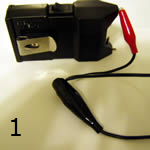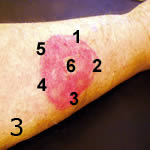Health Stewardship Education
 Bite or Sting Treatment with Mini Stun Gun
Bite or Sting Treatment with Mini Stun Gun
Quoted from Stan Abrams website spiderbitetreatment.com February 11, 2005
The site may still be found at: http://web.archive.org/web/20050206232358/
http://spiderbitetreatment.com/firstaid.htm
Watch the videos:
https://robertunsellmd.com/spider-bite-treatments/
 Welcome to my site. Contained within this site is information about the Brown Recluse Spider (BRS), loxosceles reclusa, and the possible effect of its bite. Not only does this site offer treatment for BRS bites, but also other venomous bites. A large portion of the population will come in contact with a venomous creature at some time in their lifetime. This may be nothing more than a bee sting or fire ant bite but if you have a high degree of sensitivity it can be devastating.
Welcome to my site. Contained within this site is information about the Brown Recluse Spider (BRS), loxosceles reclusa, and the possible effect of its bite. Not only does this site offer treatment for BRS bites, but also other venomous bites. A large portion of the population will come in contact with a venomous creature at some time in their lifetime. This may be nothing more than a bee sting or fire ant bite but if you have a high degree of sensitivity it can be devastating.
When the BRS is correctly identified and controlled its possible effects upon your home can be avoided. Identifying the BRS can be a tough subject, this is why we have included a BRS identification page. We offer some insight into the management of the spider and how to keep it out of your home on the BRS management page.
What I have found is that this simple first aid treatment of venomous bites from whatever source, may be all the treatment needed to resolve the problem. This treatment is introduced in the treatment section. Many testimonials from real life experiences with the BRS are included in the site. As you read some of the case histories you may find something that you can relate to. Feel free to share this information with others and particularly your caregiver.
I have practiced medicine since 1973 in both Family Practice and Emergency Medicine, and have found this treatment to be very effective. I will admit that I had my doubts at first but seeing dramatic results is a strong stimulus to change your mind. Please feel free to write me with any questions or comments you may have about this treatment.
Sincerely,
Stan Abrams, M.D.
What should I do if I get bitten by a brown recluse spider? [Or any spider]
If bitten, remain calm.
Apply an ice pack directly to the bite area to relieve swelling and pain.
Try to collect the spider, if possible, (even a mangled specimen has diagnostic value) a spider expert may be able to identify it positively. A plastic bag, small jar, or pill vial is useful and no preservative is necessary.
Immediately seek medical attention (contact your physician, hospital, and/or poison control center).
Bite Symptoms
Reactions to the Brown Recluse Spider (BRS) bite depends on the amount of venom injected, age of the spider, an individual’s immune system and sensitivity to the venom. Some people experience immediate or delayed effects as the venom kills the tissues (necrosis) at the site of the bite, while other people are unaffected by a bite.
The BRS bite may go unnoticed or feel like a pinprick. It may take 2 to 8 hours to become aware of the bite. Victims may feel a stinging sensation followed by intense pain. Symptoms range from none to general reactions that may include restlessness, generalized itching, fever, chills, nausea, vomiting, or shock. Usually a small white blister initially rises at the bite site surrounded by a swollen area. The affected area enlarges and becomes red, and the tissue is hard to the touch. A lesion from a BRS bite is a dry, blue-gray or blue white, irregular sinking patch with ragged edges and surrounding redness. Lesions can be small, about the size of a dime or larger depending on the reaction of the individual.
Depending on the reaction of the individual to the BRS bite a deep wound can result that is painful and takes a long time to heal. In cases of a severe reaction to the BRS bite, a “volcano lesion” (a hole in the flesh due to damaged, gangrenous tissue) can erupt at the bite site. The resulting open wound can range in size from a dime to the span of a hand. As the dead tissue gradually sloughs away it exposes underlying tissues. This ulcerating sore may take several weeks to months to heal with scarring resulting.
Many times it is difficult for a physician to accurately diagnose a “BRS” bite, based on the wound characteristics. The spider is needed for positive identification. Wounds that display necrotic tissue damage can result from a variety of causes such as bacteria, viruses, fungi, and other arthropods (centipedes, mites, ticks, wasps, bedbugs, kissing bugs, biting flies, etc.). Misdiagnosis of lesions as brown recluse bites can delay appropriate care.
Mini Stun Gun Use for Venomous Bites of the BRS
 The method of application of the mini stun gun for venomous bites is of the utmost importance especially for the brown recluse spider bite. The venom of the BRS has the nasty property of deep penetration and the ability to stay in the system for years, The electrode placement is important.
The method of application of the mini stun gun for venomous bites is of the utmost importance especially for the brown recluse spider bite. The venom of the BRS has the nasty property of deep penetration and the ability to stay in the system for years, The electrode placement is important.
One 10 to 12 inch extension lead made from a #14 to #10 braided copper wire (depending on availability), with a clip attached to each end. On one end I use a 1-3/8 inch insulated claw clip and on the other end an insulated small alligator clip. The reason for the claw clip is that it has a large flat surface area to make contact with the skin. The smaller alligator clip is used to grasp one of the poles of the mini stun gun.
 The wire with the clips is attached to the mini stun gun using the small alligator clip. The claw clip is placed on the opposite side of the extremity from the bite using pressure to make good skin contact. If the bite is on the abdomen then you must put the claw clip at least 10 inches away from the bite site on the abdominal wall. The other pole from the mini stun gun is applied to the skin at the bite site as close as possible. Good contact is a must; otherwise there will be an arc and a spark burn to the skin. The mini stun gun is operated for one second and then the pole is moved to the edge of the area of redness and the mini stun gun is operated again. You will need to work around the edge of inflamed area in either a clockwise or counterclockwise manner giving 5 or 6 one-second shocks to the area in total. It is not necessary to move the claw clip. The extension wire is not needed for other venomous bites.
The wire with the clips is attached to the mini stun gun using the small alligator clip. The claw clip is placed on the opposite side of the extremity from the bite using pressure to make good skin contact. If the bite is on the abdomen then you must put the claw clip at least 10 inches away from the bite site on the abdominal wall. The other pole from the mini stun gun is applied to the skin at the bite site as close as possible. Good contact is a must; otherwise there will be an arc and a spark burn to the skin. The mini stun gun is operated for one second and then the pole is moved to the edge of the area of redness and the mini stun gun is operated again. You will need to work around the edge of inflamed area in either a clockwise or counterclockwise manner giving 5 or 6 one-second shocks to the area in total. It is not necessary to move the claw clip. The extension wire is not needed for other venomous bites.
 Alligator clip (red) shown attatched to one of mini stun gun poles. Image #1
Alligator clip (red) shown attatched to one of mini stun gun poles. Image #1
Position extension wire (claw clip) to opposite side of wound. Image #2
Work mini stun gun around the wound as well as center. Image #2 & #3
It has been my experience that in one or two hours most of the pain has subsided. Any drainage should not last longer than 2 days and you should notice healing starting.
The biological basis for the mechanism behind the shock:
The current will influence the hydrogen bonds of the enzymes, destroying their secondary and tertiary structure.
The high voltage, low amperage current applied will reduce metal ions and zinc, copper, magnesium, iron, or calcium ions, which are firmly bound to some venom enzymes and are mandatory cofactors for these enzymes.
The electric particles interfere with the membrane as well as the positive charged polypeptides, decreasing their cytotoxic properties.
Taken together the protective high-voltage treatment for venomous bites is at least in part due to action of the electrical current on the venom itself.
Surgery prior to this type of treatment is not the answer since the venom has not been neutralized and the wound will break down again within a few weeks or months. This is well documented.
Stan Abrams, M.D.
-----------------------------------------------------------------------------------------------------------------------
Chris Duffy, BS, LM, CNHP, ND
midwife.duffy(at)gmail.com
Please include the word "Health Stewardship" in the Subject.